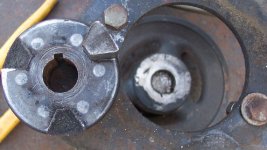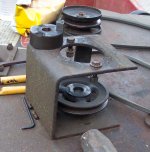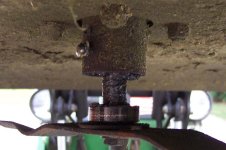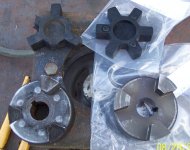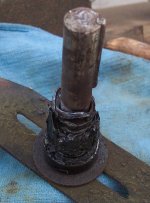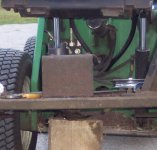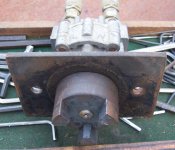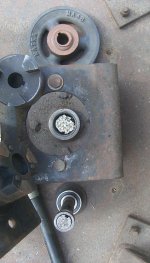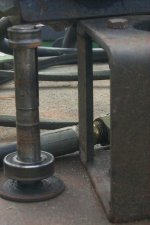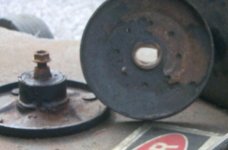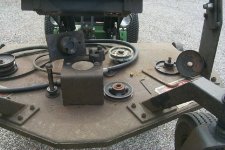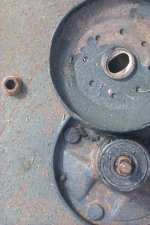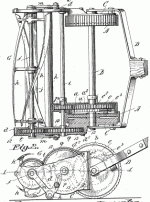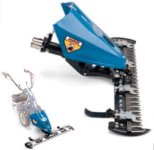Started work on the mower deck. (Broken coupler and spider.)
Took off the top motor coupler bracket from the mower bracket.
Removed mower coupler (one allen set screw holds it).
Loosened pulley set screws (two allen screws on the pulley).
Drove the spindle shaft down to get coupler off.
Placed lower spindle with blade still attached on a block of wood and lowered deck down, to push spindle back up and hold in place.
Pushed pulley (still on spindle) back down into place and tightened the two allen screws with as much pressure as I could without breaking the allen wrench.
Lifted mower deck up to check to see if there was any "play" in spindle shaft...THERE WAS!
Decided to take spindle completely out to check bearings...good thing I did, the top bearing was completely destroyed, thus the "play" in the shaft. (I replaced both of those bearings on that spindle less than a year ago!)
Also, when I loosened the pulley allen screws, despite all the pressure I thought I put on them to tighten them, I barely had to put any pressure on the allen wrench to untighten.
(Not a good design if you ask me. If those allen screws for the pulley and coupler come loose, the shaft can begin a downward slide with all that vibration.)
So, I now have to stop again to order new bearings.
I am going to try and post some pics, but I am not sure how to do that.
Any help would be appreciated.
Took off the top motor coupler bracket from the mower bracket.
Removed mower coupler (one allen set screw holds it).
Loosened pulley set screws (two allen screws on the pulley).
Drove the spindle shaft down to get coupler off.
Placed lower spindle with blade still attached on a block of wood and lowered deck down, to push spindle back up and hold in place.
Pushed pulley (still on spindle) back down into place and tightened the two allen screws with as much pressure as I could without breaking the allen wrench.
Lifted mower deck up to check to see if there was any "play" in spindle shaft...THERE WAS!
Decided to take spindle completely out to check bearings...good thing I did, the top bearing was completely destroyed, thus the "play" in the shaft. (I replaced both of those bearings on that spindle less than a year ago!)
Also, when I loosened the pulley allen screws, despite all the pressure I thought I put on them to tighten them, I barely had to put any pressure on the allen wrench to untighten.
(Not a good design if you ask me. If those allen screws for the pulley and coupler come loose, the shaft can begin a downward slide with all that vibration.)
So, I now have to stop again to order new bearings.
I am going to try and post some pics, but I am not sure how to do that.
Any help would be appreciated.
